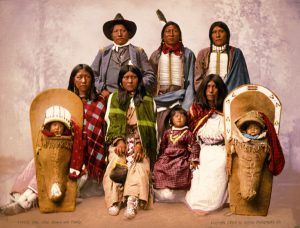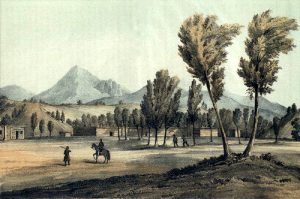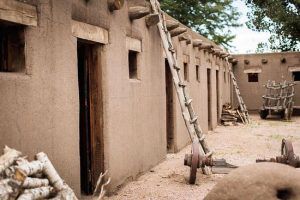Any of the Jicarilla Apache whom Lieutenant Colonel Philip St. George Cooke’s campaign of the Apache War of 1854 had failed to subdue took refuge with the Ute Indians, who lived in the mountains bordering the San Luis Valley of southern Colorado (then part of the Territory of New Mexico.) Hardly had the Jicarilla troubles subsided than the Ute went on the rampage.
On Christmas Day 1854, about 100 Ute and a few Jicarilla descended on El Pueblo in Colorado. They killed 15 men, captured two women, and ran off all the stock. Then they crossed the Sangre de Cristo Mountains and attacked a settlement recently founded in the San Luis Valley near where Alamosa, Colorado now stands. General John Garland decided to treat the Ute as he had the Jicarilla Apache.
Colonel Thomas T. Fauntleroy and units of the 1st Dragoons had replaced Colonel Cooke and the 2d Dragoons at Fort Union, New Mexico. Strengthened by regular companies from other forts and six companies of New Mexico volunteers under Lieutenant Colonel Ceran St. Vrain, Colonel Fauntleroy took the field with some 500 men early in February 1855.
Establishing a base of operations at Fort Massachusetts, Colorado, on the San Luis Valley’s eastern edge, Fauntleroy scoured the basin and surrounding mountains for hostile camps. Men and horses suffered from intense cold and deep snow plaguing Colonel Philip St. George Cooke a year earlier, but relentless pursuit yielded results. On March 19th, the troops skirmished with a war party near Poncha Pass, killed eight warriors, and captured the party’s entire pony herd after a four-day chase.
Next, Fauntleroy split his command. While he and the regulars continued to search the San Luis Valley, St. Vrain’s volunteers rode to the plains east of the Sangre de Cristo Mountains to look for Ute Indians. On April 25th, the New Mexicans jumped a band of 60 Indians on the Huerfano River, killing or capturing 13 and putting the rest to flight.
Fauntleroy tasted victory. On the night of April 28th, his men crept undetected into positions on two sides of a Ute camp estimated to contain 150 warriors. Bonfires illumined the village, and the Indians were in the midst of a riotous war dance. Suddenly the blackness at the edge of the village erupted with rifle fire that raked the lodges with devastating effect. It “swept the enemy like chaff before the wind,” Fauntleroy recalled, and they scattered in fright in the opposite direction. The soldiers charged through the village and, for about 25 minutes pressing the surprised dancers in a running fight. Then they returned to burn the lodges, food, and other supplies in the village. The colonel counted 40 Ute slain by the murderous fire of his men.
This battle broke the Ute resistance. There were several more skirmishes, but in July 1855, the Indians sued for peace. Fauntleroy returned to Fort Union, and the volunteers were mustered out of the service.
Compiled by Kathy Weiser-Alexander/Legends of America, updated April 2021.
Also See:
Indian Wars, Battles & Massacres
Source: National Park Service



